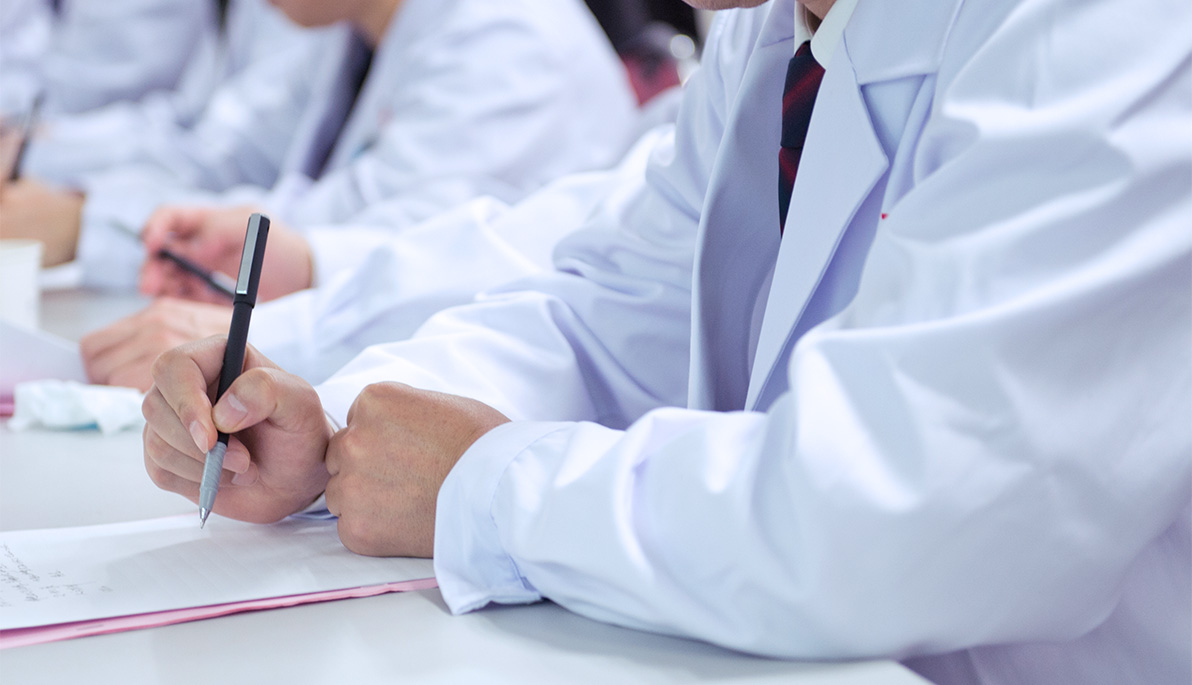News
Students Tackle Today’s Med School Challenges
May 10, 2017
Medical schools face many challenges—students need to maintain their physical and emotional wellbeing in the face of great pressure, while faculty and staff members must develop a flexible and dynamic curricula, experiential learning opportunities, and ways for students to achieve success on osteopathic licensing exams.
Faculty members and students from NYIT College of Osteopathic Medicine (NYITCOM) presented a variety of solutions to these challenges at the at the American Association of Colleges of Osteopathic Medicine (AACOM) and Association of Osteopathic Directors and Medical Educators (AODME) 2017 Annual Conference, which was held in Baltimore, M.D., this spring. Learn more about the presentations, which focused on a common theme of Educating Leaders for Integrated Health Systems:
Fit Physician—A Novel Approach to Physical and Nutrition Education in Medical Students
Fourth-year medical student and Academic Medicine Scholar Alex Stangle discussed NYITCOM’s Fit Physician program, a study utilizing Fitbit activity trackers to measure physical activity in first year osteopathic medical students. The study monitored the activity of 120 students during various experiences, including monthly lectures on nutrition, weekly walks with professors, and regular fitness challenges. The team measured activity level (in steps), sleep quality, body composition, academic performance, and stress levels. Results will be announced in early summer.
“Physicians spend their time caring for others, but they themselves require support to maintain their own wellbeing,” said Stangle. “Studies have shown that medical students who develop and maintain positive lifestyle habits are likely to increase their physical activity and wellness counseling in practice after graduation.” The hope, explained Stangle, is that healthier medical students will become healthier doctors, who in turn will help their patients maintain the same positive level of wellbeing.
Measurable Factors Predicting Outcomes of Licensing Examinations
William Blazey, D.O., associate professor and assistant dean, preclinical education, at NYITCOM, and third-year medical students and Academic Medicine Scholars Filippo Romanelli and George Koutsouras discussed predictive factors and study habits that contribute to better performance on the Comprehensive Osteopathic Medical Licensing Exam 1 (COMLEX 1), the first of three COMLEX medical exams required for osteopathic physician licensing. The team analyzed study habits, including when students begin studying, total hours spent studying, and various exam preparation tools to determine factors that led to successful results on national board exams. The investigation discovered that students who begin studying for board exams by January performed better on the exam and that students who took both the COMLEX and the United States Medical Licensing Examination (USMLE)—the exam taken by M.D.s for licensure—scored 100 points higher on COMLEX than students who did not take USMLE.
“Our students are one of our best resources for research in all fields, but especially exam performance,” said Blazey. “They ask the questions that matter to student success: Why? How? What if?”
Medical Students Acquire Management Skills by Operating a Free Clinic
Third-year medical students Inna Bulavsky and Alexander Nello teamed up with NYITCOM assistant professors Sonia Rivera-Martinez, D.O., and Karen Sheflin, D.O., to review the organizational structure and administration of NYITCOM’s student-run free clinic in Central Islip, N.Y. Presenters discussed the ways the clinic enables students to experience different aspects of managing a facility, including patient advocacy, community outreach, continuity of care, financial matters, and human resources.
Preparing Students to Integrate Basic Sciences into the Clinical Clerkship Years
Donna-Marie McMahon, D.O., director of NYITCOM Doctor-Patient Continuum (a preclinical curriculum that inspires medical students to become self-directed learners), and Christine Hutak, Ph.D., academic coordinator of the NYITCOM Doctor-Patient Continuum, joined educators from Lake Erie College of Osteopathic Medicine (LECOM) at Bradenton to discuss the benefits of flexible, dynamic programs within osteopathic medical schools. McMahon and Hutak demonstrated how the NYITCOM doctor-patient curriculum integrates basic science into clinical case scenarios and how feedback from students and faculty members constantly reshape the program’s cases to be relevant and current with the needs of today’s students.
Comparison of Osteopathic and Allopathic Medical Student Interest in Family Medicine
According to the Association of American Medical Colleges, there is a shortage of doctors practicing family medicine. Third-year student Alyssa Toia delved into this phenomenon by examining whether there were different levels of interest in family medicine in osteopathic and allopathic (M.D.) programs. By looking at family medicine residency programs, she found that more osteopathic medical students applied and matched to the programs than allopathic students. Toia also noted that despite the high interest among osteopathic medical students, residency positions in family medicine programs remain unfilled each year.
“The opportunity to present my research findings at AACOM was a rewarding and enriching experience. I look forward to integrating research with medicine throughout my career,” Toia said.





